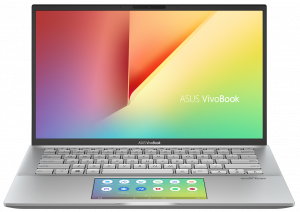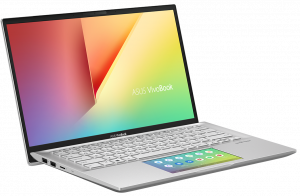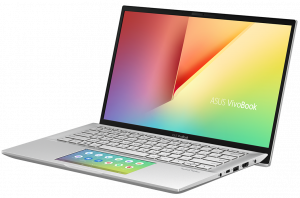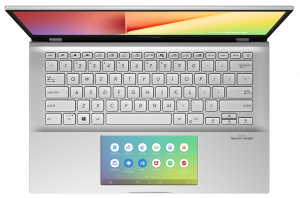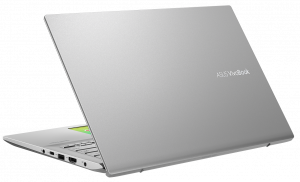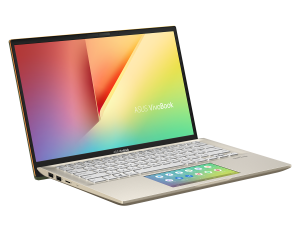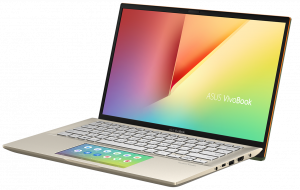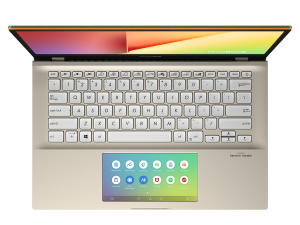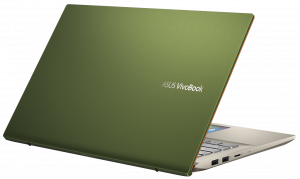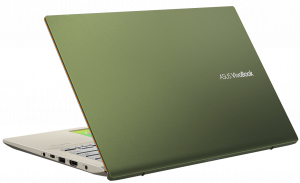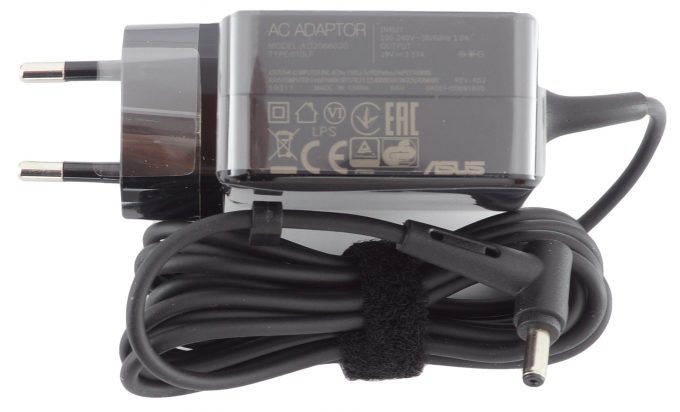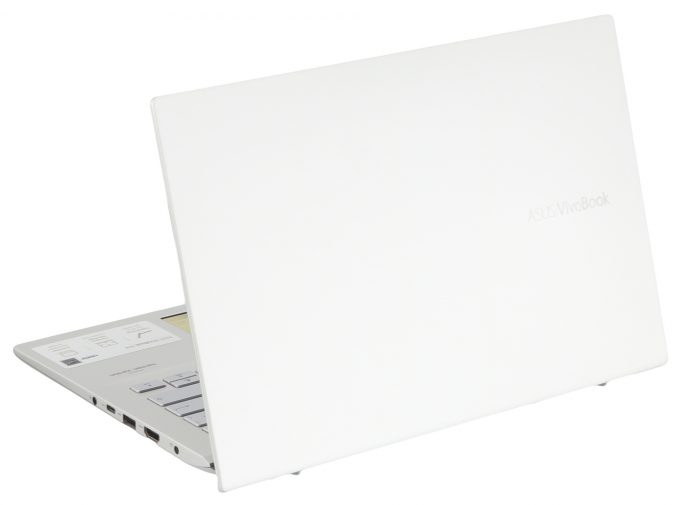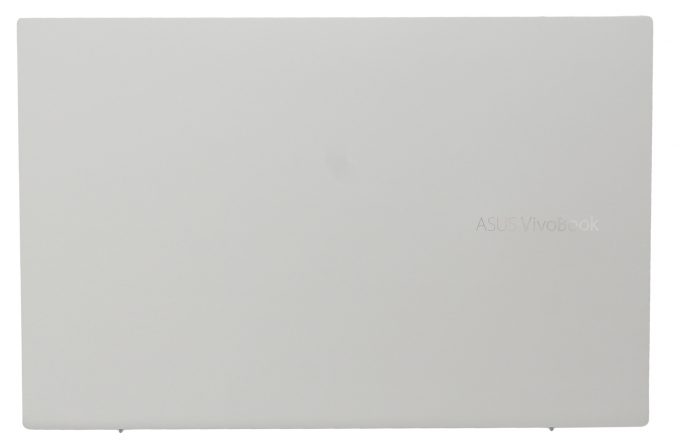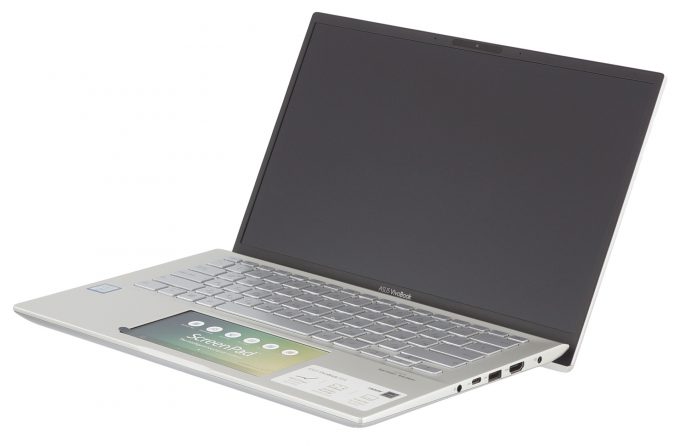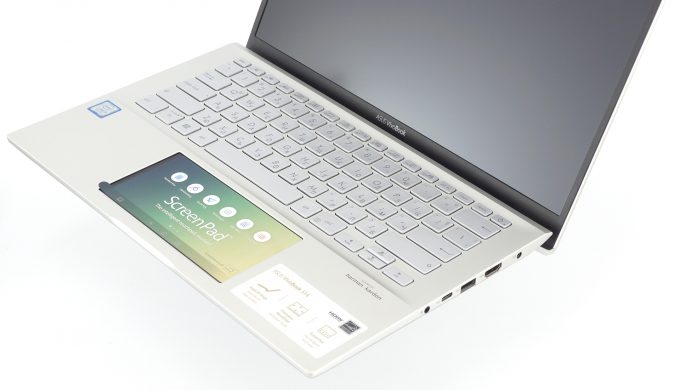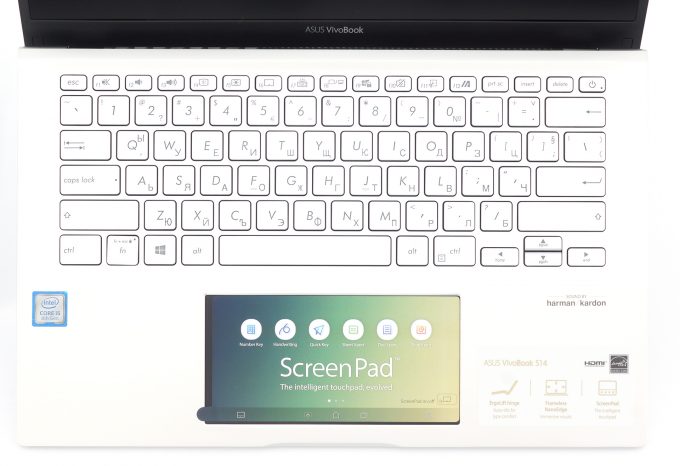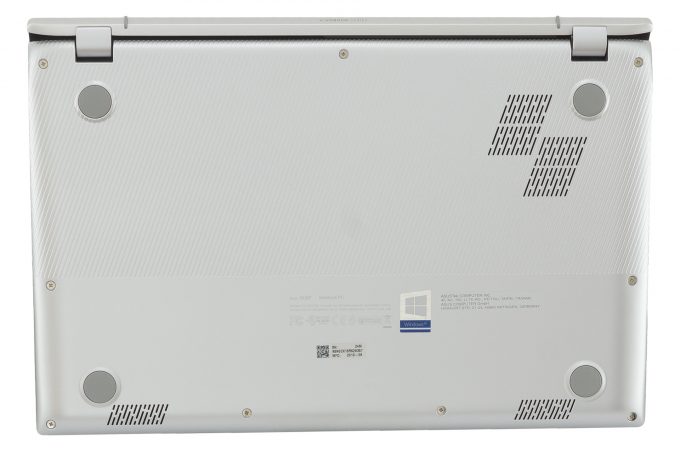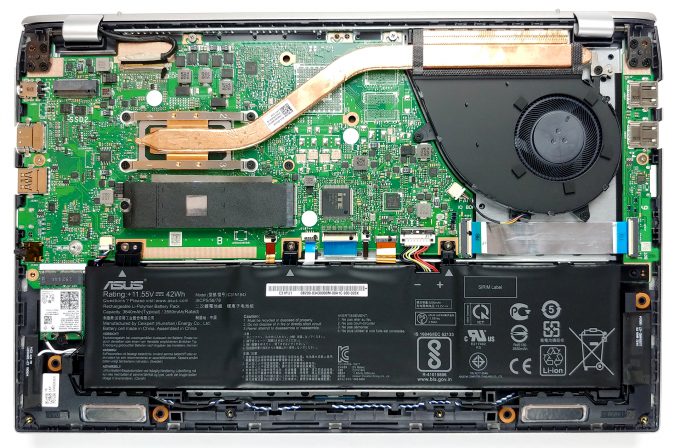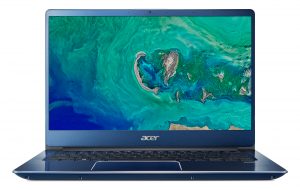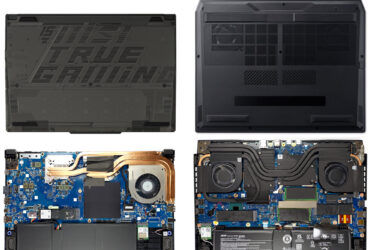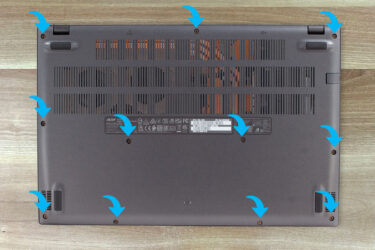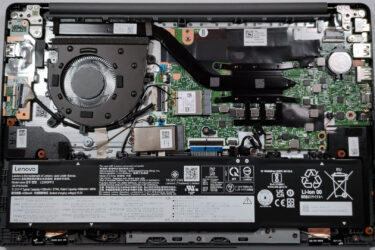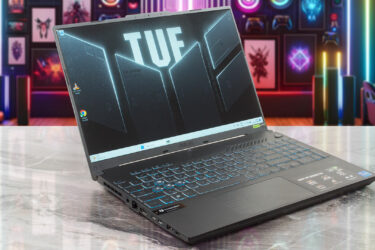ASUS VivoBook S14 S432 review – the ScreenPad 2.0 changes the experience quite drastically
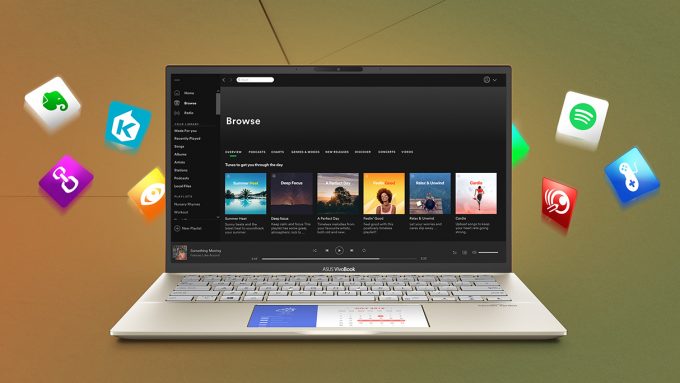 On your display, there is the new VivoBook S14. Its full name would be the ASUS VivoBook S14 S432 – typically pretty mouthful to say. It now features the second generation ScreenPad, seen on the latest ZenBooks and the larger VivoBook S15 S532. Additionally, the outlooks of the new model don’t differ pretty much from last year – it just looks sleeker and a tad more premium.
On your display, there is the new VivoBook S14. Its full name would be the ASUS VivoBook S14 S432 – typically pretty mouthful to say. It now features the second generation ScreenPad, seen on the latest ZenBooks and the larger VivoBook S15 S532. Additionally, the outlooks of the new model don’t differ pretty much from last year – it just looks sleeker and a tad more premium.
Despite the innovation that has taken a step with this one, we are sadly seeing a Whiskey Lake processor line-up on the inside. However, while we were writing this review, we were notified that the laptop would come with the Comet Lake processors, as more and more manufacturers are updating their devices with the latest duo of 10th Gen. Intel processors.
Nevertheless, we are eager to see how the ScreenPad 2.0 fits inside this chassis and wether the VivoBook can challenge its more premium brother – the ZenBook 14 UX434.
You can check the prices and configurations in our Specs System: https://laptopmedia.com/series/asus-vivobook-s14-s432/
Contents
Specs Sheet
- HDD/SSD
- up to 1000GB SSD
- RAM
- up to 8GB
- OS
- Windows 10 Home, Windows OS
- Battery
- 42Wh, 3-cell
- Dimensions
- 322 x 211 x 18 mm (12.68" x 8.31" x 0.71")
- Weight
- 1.40 kg (3.1 lbs)
- Ports and connectivity
- 1x USB Type-C
- 3.2 Gen 1 (5 Gbps)
- 1x USB Type-A
- 3.2 Gen 1 (5 Gbps)
- 2x USB Type-A
- 2.0
- HDMI
- Card reader
- MicroSD
- Wi-Fi
- 802.11ac
- Bluetooth
- 5.0
- Audio jack
- 3.5 mm combo
- Features
- Fingerprint reader
- Web camera
- IR HD
- Backlit keyboard
- optional
- Microphone
- Array microphone with Cortana voice-recognition support
- Optical drive
- Security Lock slot
All Asus Vivobook S14 S432 configurations
What’s in the box?
Expectedly, inside the package, there is not much to see, apart from the laptop itself and the 65W power adapter. Once again, the device is charged via a barrel-style plug, rather than USB Type-C, which is a bit of a bummer.
Design and construction
Starting with the design features of this new model, we see a metal sheet on the lid, which is most probably made out of aluminum. Despite that, the rest of the device is made out of plastic. One of the good features of this matte finish, the device has, is hard to stick fingerprints. In terms of size, the VivoBook S14 S432 has a height of 18mm and weighs around 1.40 kg.
From our experience, the lid cannot be opened with a single hand, but it is good to see the ErgoLift mechanism. As you may already know, it raises the backside of the base for better breathing of the fan and a somewhat improved ergonomics. Not only that, but this results in very little in size bezels all around the display. Nevertheless, ASUS was able to mount an IR face recognition system up above the screen – not bad.
Now, moving to the base of the notebook, we see the keyboard, which is traditionally good on these devices. It features a decent key travel, nice and clicky feedback. With the inclusion of a backlight, we would like to transfer our focus on the ScreenPad.
Not only it is super big in size in comparison to what we are used to seeing on Windows machines, but it also has a great resolution – 2160 x 1080 to be precise. It can be turned on and off via the “F6” key and you can switch between a second display and a regular touchpad mode. In terms of regular usage, the touchpad is pretty decent – has accurate readings and a rather fast detection.
However, what is more, interesting are the features that come with the ScreenPad 2.0 package. If we have to be honest, ASUS already has a good description of its usability, so it might be a good idea if you pay a visit to its official Web page. Nevertheless, you can use the secondary display to assign shortcuts, watch a video, or put virtually any app on it – we found the Spreadsheets and calculator to be extremely useful. Moreover, you can use the ScreenPad to write with your own fingertips, which is then transcoded into digital text – pretty neat.
Lastly, when we turn the laptop upside down, we see the ventilation grills, as well as the two speakers. Expectedly, the heat exhaustion happens from in between the base and the display compartment.
Ports
On the left side of this laptop, you are going to find two USB Type-A 2.0 ports, as well as a MicroSD card reader. On the right, there is the power plug, an HDMI connector, followed by two USB 3.1 (Gen. 1) ports – one of Type-A and one of Type-C. Then last, but not least, there is an Audio Jack.
Disassembly, upgrade options and maintenance
What is preventing you from digging inside the internals of this laptop are 9 Phillips-head screws, some clips and the Vodka you drank last night. So, if you remove the screws and pop the bottom plate open with a plastic tool, you would only need a couple of glasses of Cabbage juice and you can now do the job.
In terms of cooling, there is one pretty beefy heat pipe doing the heavy lifting. In addition to that, there is a rather long heat spreader, as well as a medium-sized fan.
Upgradability-wise, the device sucks a little bit. All of the RAM is soldered to the motherboard, hence you would not be able to put more even if you badly wanted. On the bright side, you can upgrade the storage with an NVMe PCIe SSD, that slots right inside of the already busy M.2 slot.
Finally, there is the battery. It has a capacity of 42Wh, which should be enough, given the energy-efficient hardware.
Display quality
ASUS VivoBook S14 S432 has a Full HD IPS display, model number Chi Mei N140HAC-EAC (CNM14D4). Its diagonal is 14″ (35.56 cm), and the resolution – 1920 х 1080. Additionally, the screen ratio is 16:9, the pixel density – 157 ppi, their pitch – 0.161 x 0.161 mm. The screen can be considered Retina when viewed from at least 56 cm (from this distance, the average human eye can’t see the individual pixels).
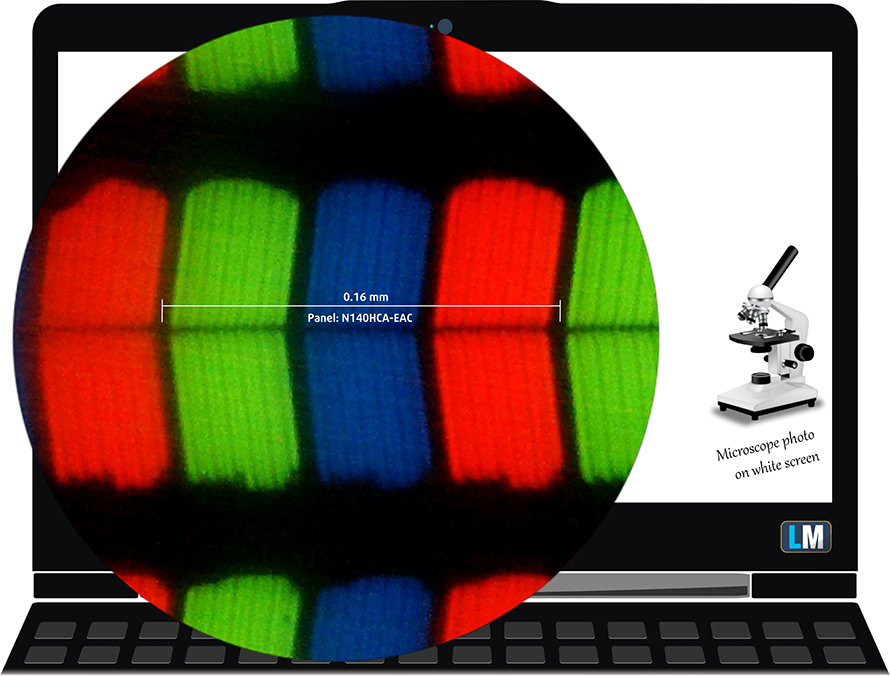
This is what the ScreenPad looks like under a microscope.
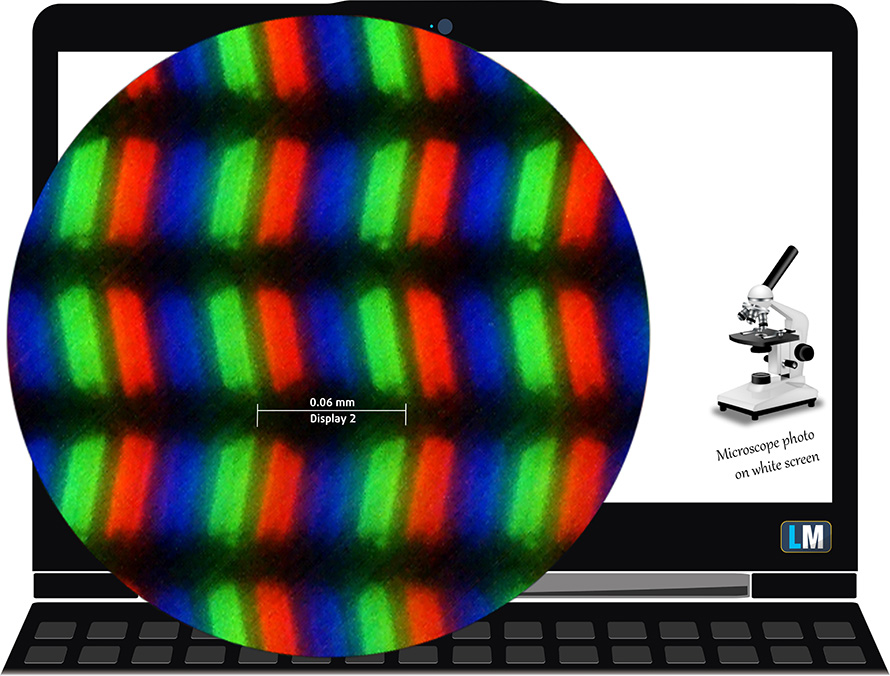
Its viewing angles are excellent. We have provided images at 45 degrees to evaluate quality.

The maximum measured brightness of the main display is 245 nits (cd/m2) in the middle of the screen and 231 nits (cd/m2) average across the surface with a maximum deviation of 17% in the bottom left the corner. The Correlated Color Temperature on a white screen and at maximum brightness is 6830K (average) – slightly colder than the 6500K optimum for sRGB. The average color temperature through the grey scale before profiling is 6800K.
In the illustration below you can see how the display performs from a uniformity perspective. The illustration below shows how matters are for operational brightness levels (approximately 140 nits) – in this particular case at 54% Brightness (White level = 144 cd/m2, Black level = 0.13 cd/m2).
Values of dE2000 over 4.0 should not occur, and this parameter is one of the first you should check if you intend to use the laptop for color-sensitive work (a maximum tolerance of 2.0 ). The contrast ratio is very good – 1100:1.
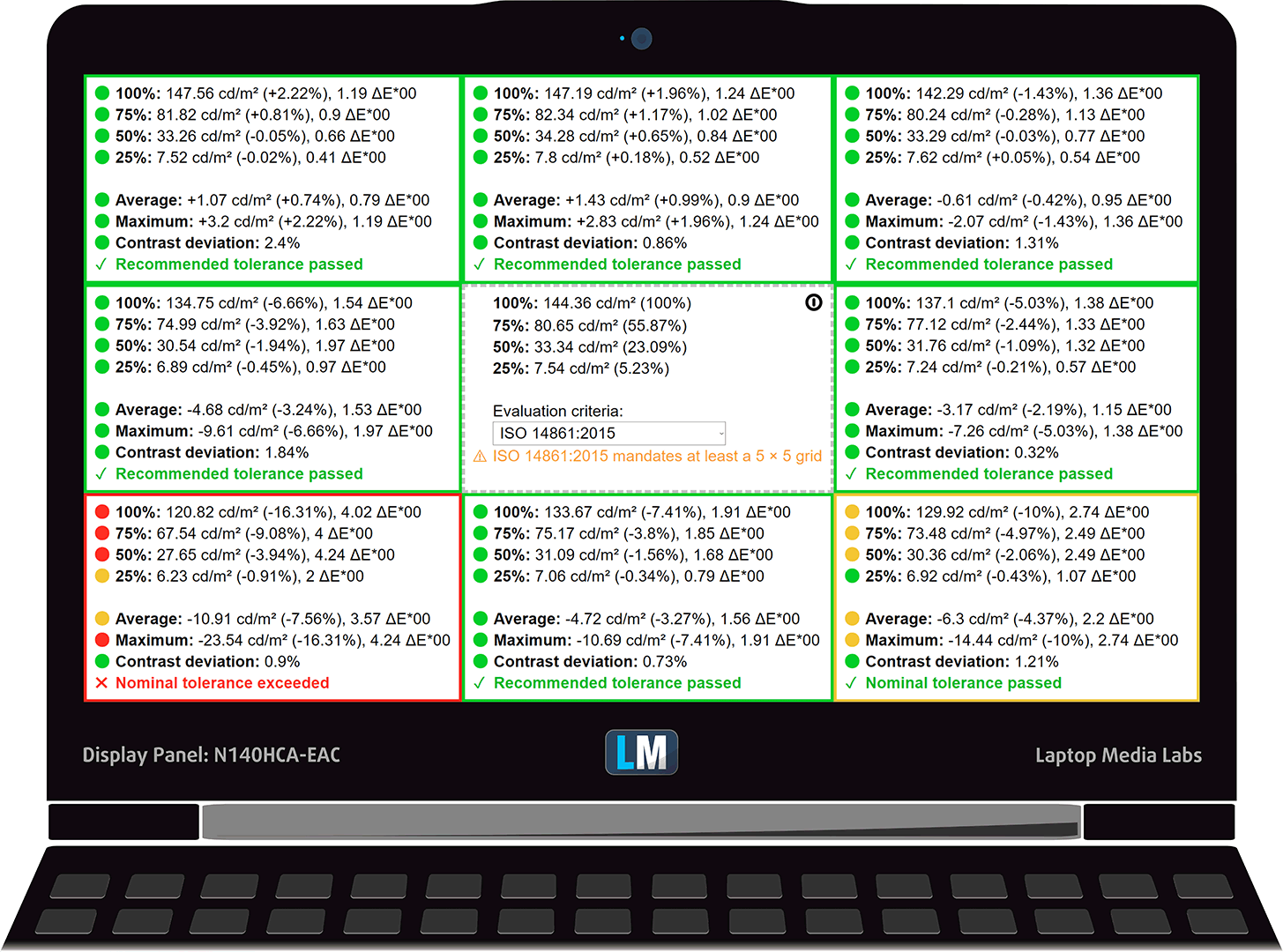
To make sure we are on the same page, we would like to give you a little introduction to the sRGB color gamut and the Adobe RGB. To start, there’s the CIE 1976 Uniform Chromaticity Diagram that represents the visible specter of colors by the human eye, giving you a better perception of the color gamut coverage and the color accuracy.
Inside the black triangle, you will see the standard color gamut (sRGB) that is being used by millions of people in HDTV and on the web. As for the Adobe RGB, this is used in professional cameras, monitors, etc for printing. Colors inside the black triangle are used by everyone and this is an essential part of the color quality and color accuracy of a mainstream notebook.
Still, we’ve included other color spaces like the famous DCI-P3 standard used by movie studios, as well as the digital UHD Rec.2020 standard. Rec.2020, however, is still a thing of the future and it’s difficult for today’s displays to cover that well. We’ve also included the so-called Michael Pointer gamut, or Pointer’s gamut, which represents the colors that naturally occur around us every day.
The yellow dotted line shows ASUS VivoBook S14 S432’s color gamut coverage.
Its display covers just 54% of the sRGB/ITU-R BT.709 (web/HDTV standard) in CIE1976.

Simultaneously, the ScreenPad has a vastly superior color coverage – 93% of sRGB.
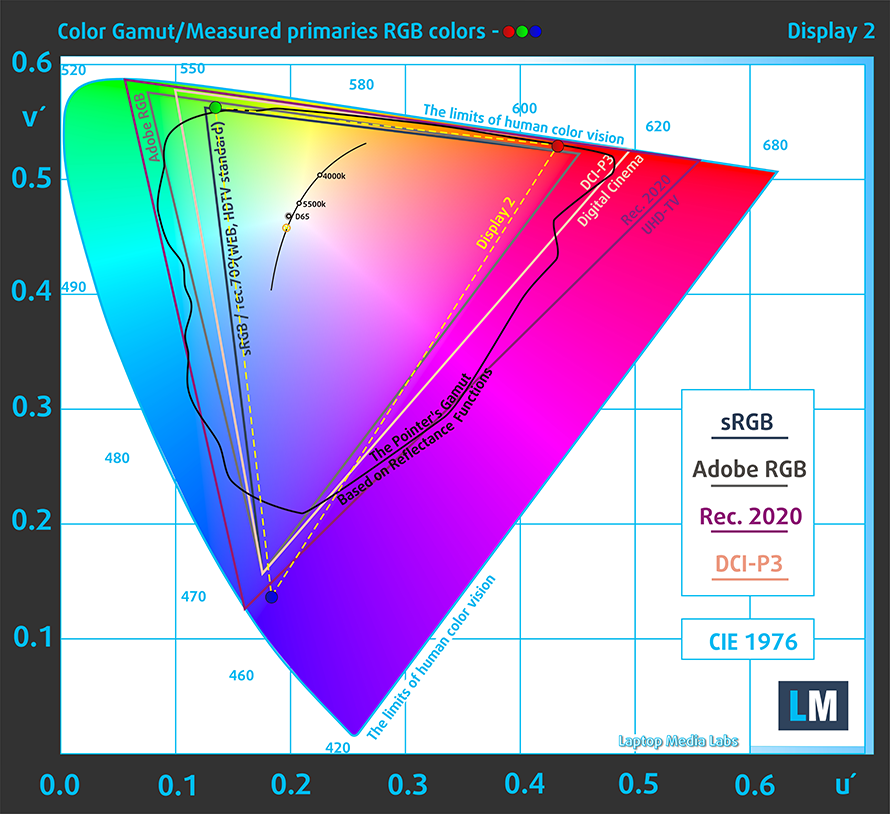
Our “Design and Gaming” profile delivers optimal color temperature (6500K) at 140 cd/m2 luminance and sRGB gamma mode.
We tested the accuracy of the main display with 24 commonly used colors like light and dark human skin, blue sky, green grass, orange, etc. You can check out the results at factory condition and also, with the “Design and Gaming” profile.
Below you can compare the scores of ASUS VivoBook S14 S432 with the default settings (left), and with the “Gaming and Web design” profile (right).
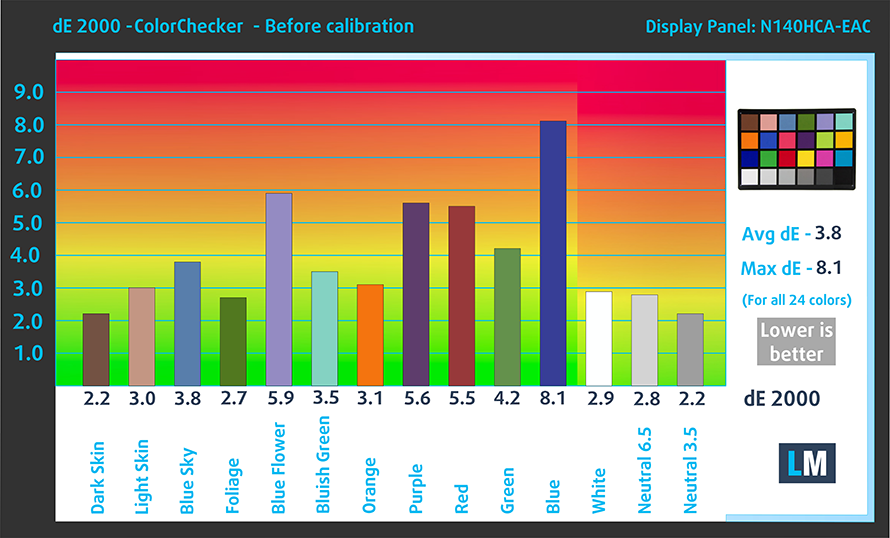
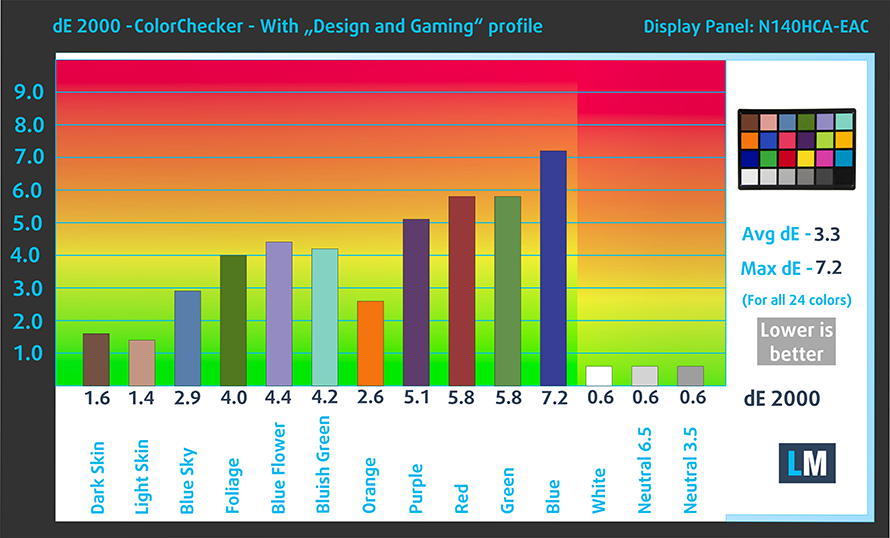
The next figure shows how well the display can reproduce dark parts of an image, which is essential when watching movies or playing games in low ambient light.
The left side of the image represents the display with stock settings, while the right one is with the “Gaming and Web Design” profile activated. On the horizontal axis, you will find the grayscale and on the vertical axis – the luminance of the display. On the two graphs below you can easily check for yourself how your display handles the darkest nuances but keep in mind that this also depends on the settings of your current display, the calibration, the viewing angle, and the surrounding light conditions.
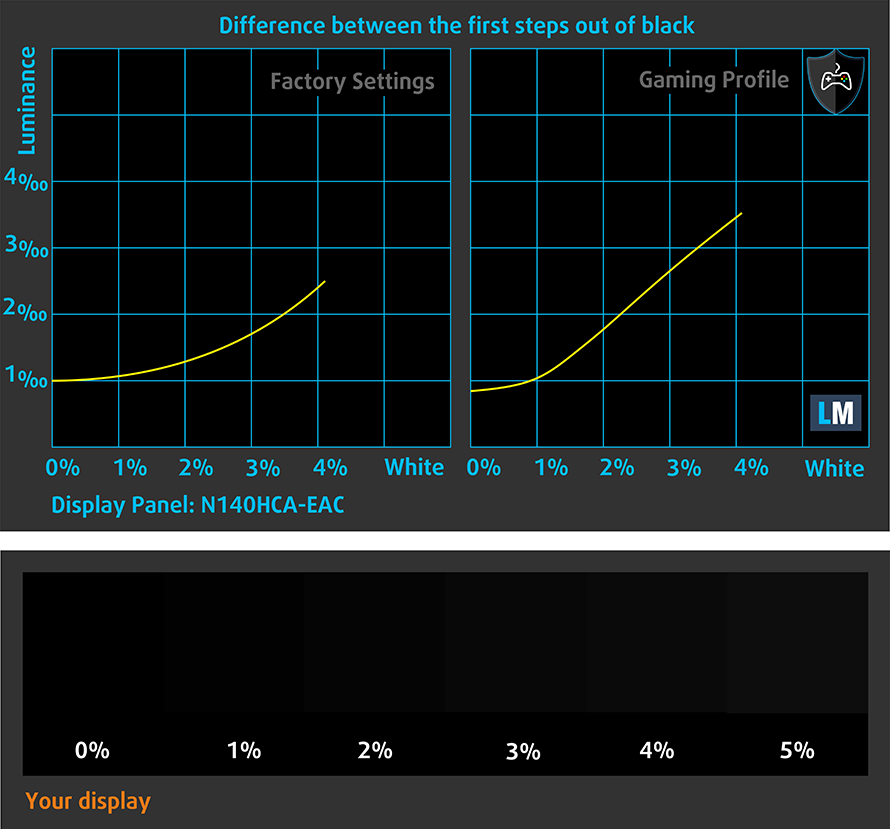
Response time (Gaming capabilities)
We test the reaction time of the pixels with the usual “black-to-white” and “white-to-black” method from 10% to 90% and vice versa.
We recorded Fall Time + Rise Time = 28 ms

Health impact – PWM / Blue Light
PWM (Screen flickering)
Pulse-width modulation (PWM) is an easy way to control monitor brightness. When you lower the brightness, the light intensity of the backlight is not lowered, but instead turned off and on by the electronics with a frequency indistinguishable to the human eye. In these light impulses, the light/no-light time ratio varies, while brightness remains unchanged, which is harmful to your eyes. You can read more about that in our dedicated article on PWM.
ASUS VivoBook S14 S432’s display is using PWM to adjust the brightness up to 60 nits. After that its flicker-free. Moreover, the PWM it uses has a very high frequency, making the display comfortable for long hours of work and safe for your eyes in this aspect.
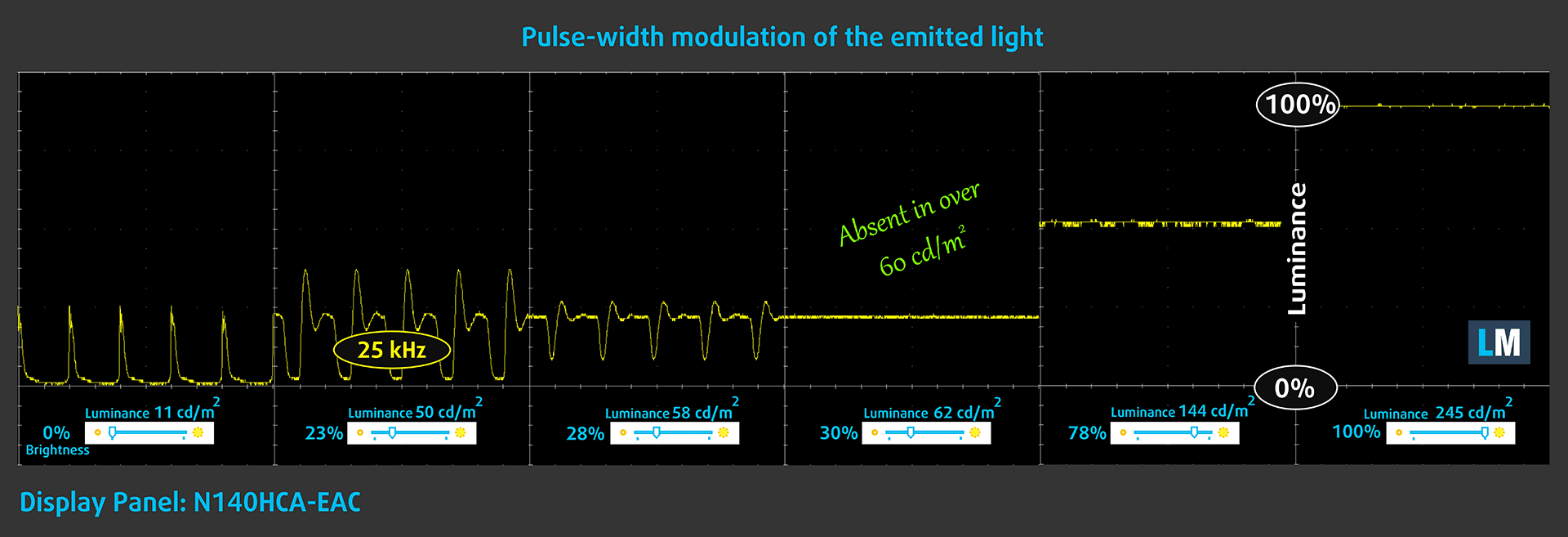
Blue light emissions
Installing our Health-Guard profile not only eliminates PWM but also reduces the harmful Blue Light emissions while keeping the colors of the screen perceptually accurate. If you’re not familiar with the Blue light, the TL;DR version is – emissions that negatively affect your eyes, skin and your whole body. You can find more information about that in our dedicated article on Blue Light.
Conclusions
ASUS VivoBook S14 S432’s main display has an IPS panel with a Full HD resolution, great viewing angles, and good contrast ratio. As a disadvantage, we consider the narrow color coverage and the non-uniform luminosity of the backlight.
Buy our profiles
Since our profiles are tailored for each display model, this article and its respective profile package are meant for ASUS VivoBook S14 S432 configurations with 14.0″ Chi Mei N140HCA-EAC (CMN14D4) (FHD, 1920 × 1080) IPS panel.
*Should you have problems with downloading the purchased file, try using a different browser to open the link you’ll receive via e-mail. If the download target is a .php file instead of an archive, change the file extension to .zip or contact us at [email protected].
Read more about the profiles HERE.
In addition to receiving efficient and health-friendly profiles, by buying LaptopMedia's products you also support the development of our labs, where we test devices in order to produce the most objective reviews possible.

Office Work
Office Work should be used mostly by users who spend most of the time looking at pieces of text, tables or just surfing. This profile aims to deliver better distinctness and clarity by keeping a flat gamma curve (2.20), native color temperature and perceptually accurate colors.

Design and Gaming
This profile is aimed at designers who work with colors professionally, and for games and movies as well. Design and Gaming takes display panels to their limits, making them as accurate as possible in the sRGB IEC61966-2-1 standard for Web and HDTV, at white point D65.
Get all 3 profiles with 33% discount
Sound
ASUS VivoBook S14 S432 has a decent sound quality. Its speakers are tuned by Harman Kardon and their low, mid and high tones are clear of deviations.
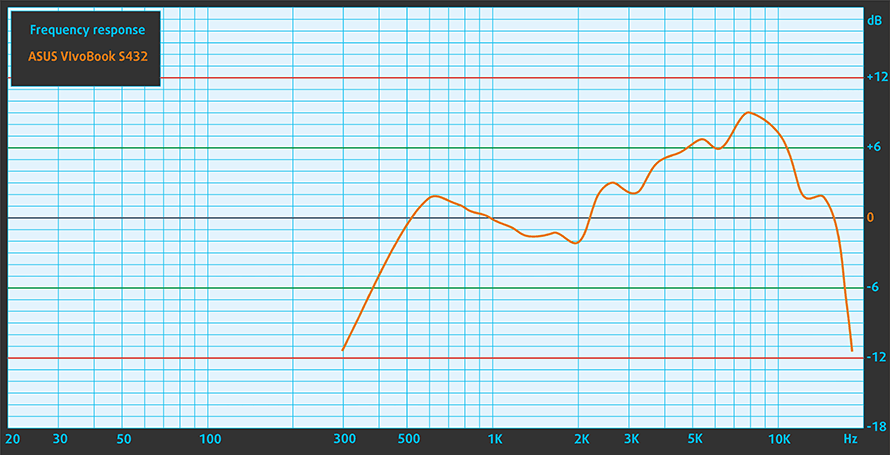
Drivers
You can download all of the drivers and utilities for this device from here: https://www.asus.com/us/Laptops/ASUS-VivoBook-S14-S432FA/HelpDesk_Download/
Battery
Now, we conduct the battery tests with Windows Better performance setting turned on, screen brightness adjusted to 120 nits and all other programs turned off except for the one we are testing the notebook with. This laptop comes with a 42Wh unit.
We were able to get almost 10 hours of Web browsing and 9 hours and a half of video playback from it – not bad.
In order to simulate real-life conditions, we used our own script for automatic web browsing through over 70 websites.
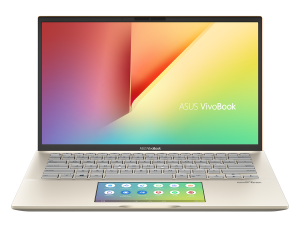
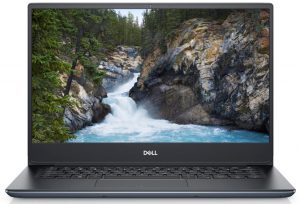
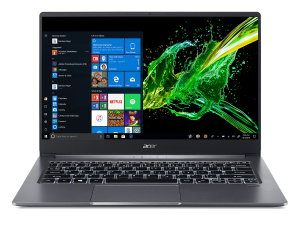
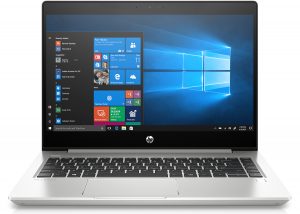
For every test like this, we use the same video in HD.




We use F1 2017’s built-in benchmark on loop in order to simulate real-life gaming.




CPU options
As of right now, this notebook is sold with the Core i5-8265U and the Core i7-8565U. Additionally, you can also get it with the Core i5-10210U and the Core i7-10510U – all of them are quad-core CPUs with eight threads.
Results are from the Cinebench 20 CPU test (the higher the score, the better)
Results are from our Photoshop benchmark test (the lower the score, the better)
GPU options
Apart from the integrated graphics, you can purchase the laptop with an NVIDIA GeForce MX250 with 2GB of GDDR5 memory.
Results are from the 3DMark: Fire Strike (Graphics) benchmark (higher the score, the better)
Results are from the Unigine Superposition benchmark (higher the score, the better)
Gaming tests

| DOTA 2 | HD 1080p, Low (Check settings) | HD 1080p, Normal (Check settings) | HD 1080p, High (Check settings) |
|---|---|---|---|
| Average FPS | 81 fps | 40 fps | 18 fps |
Temperatures and comfort
Max CPU load
In this test we use 100% on the CPU cores, monitoring their frequencies and chip temperature. The first column shows a computer’s reaction to a short load (2-10 seconds), the second column simulates a serious task (between 15 and 30 seconds), and the third column is a good indicator of how good the laptop is for long loads such as video rendering.
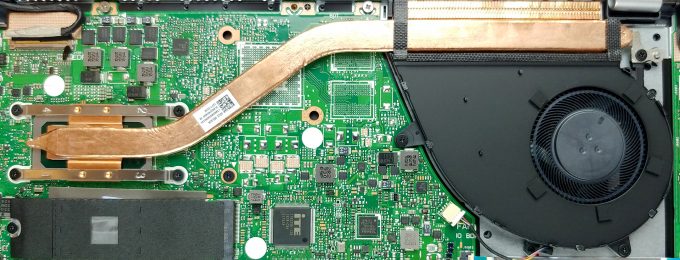
Average core frequency (base frequency + X); CPU temp.
| Intel Core i5-8265U (15W TDP) | 0:02 – 0:10 sec | 0:15 – 0:30 sec | 10:00 – 15:00 min |
|---|---|---|---|
| ASUS VivoBook S14 S432 | 2.93 GHz (B+83%) @ 66°C | 2.85 GHz (B+78%) @ 79°C | 1.97 GHz (B+23%) @ 62°C |
| Lenovo Ideapad L340 (15″) | 3.27 GHz (B+104%)@ 72°C | 1.99 GHz (B+24%)@ 60°C | 2.01 GHz (B+26%)@ 65°C |
| ASUS VivoBook S15 S532 | 2.96 GHz (B+85%) @ 75°C | 2.95 GHz (B+84%) @ 90°C | 2.17 GHz (B+36%) @ 68°C |
| Lenovo ThinkBook 13s | 2.76 GHz (B+73%)@ 75°C | 2.74 GHz (B+71%)@ 84°C | 2.11 GHz (B+32%)@ 74°C |
| Lenovo ThinkPad T490s | 3.43 GHz (B+114%)@ 91°C | 2.69 GHz (B+68%)@ 91°C | 2.19 GHz (B+37%)@ 80°C |
| HP ProBook 450 G6 | 2.69 GHz (B+59%)@ 64°C | 2.53 GHz (B+60%)@ 68°C | 2.09 GHz (B+31%)@ 71°C |
Traditionally, the VivoBook S14 S432’s cooling is on point. First, the close to 3.00 GHz speeds, in the beginning, is pretty stable for a good amount of time. Additionally, the temperatures never exceeded 80C, while the noise remained rather low. In the end, the clocks were close to 2.00 GHz, while the temperature was as low as 62C.
Comfort during full load
As we said, noise is not obnoxious, while the outsides can get up to 40C, which is warm, but not too much.
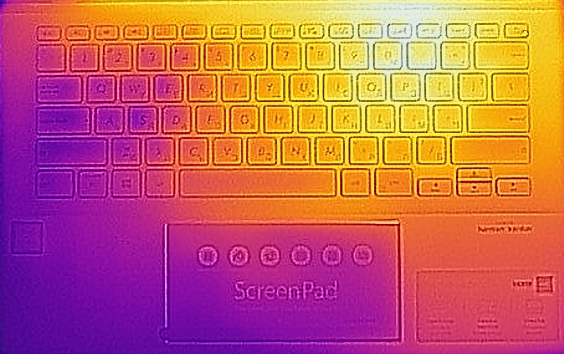

Verdict
What we had today was a really solid machine. Despite some downsides, which honestly were pretty petty not to be fixed, we think that the VivoBook S14 S432 would make a great addition to the home of people that need a fast, portable and sleek looking laptop. Similarly to the ZenBook notebooks of this year, this device is embracing innovation, rather than sticking to the old and well established.
As we tested it, the ScreenPad 2.0 works pretty seamlessly and offers a very intuitive workflow. However, we have to praise ASUS for what they tried and achieved, because if you look at it from a different perspective, they had a good chance to fail. Even if a minor driver issue persists, the notebook could have not worked as intended, which would have raised a lot of eyebrows and question ASUS’ ethics of work. Yet they accepted the risk and succeeded, even further developing the tech into the ZenBook Duo devices.
Now back on the VivoBook S14 S432, it has a great battery life, offering its users around 9 and a half to 10 hours of Web browsing and video playback. Additionally, the performance, provided by its efficient CPUs is staggering, compared to some of the opposition.
Next, there is the display. While it has an IPS panel with great viewing angles, good contrast ratio and lack of aggressive PWM, we have to note that it has some mediocre maximum brightness, covers only half of the colors in sRGB and is not very uniform in terms of luminosity. All of the aforementioned is a common trait for the budget IPS displays.
Another thing we were not particularly happy with is the poor upgradability, given by the soldered memory chips. Additionally, the laptop doesn’t have Thunderbolt connectivity, and two of its USB Type-A ports an only 2.0 speeds. On the bright side, it features a MicroSD card slot.
So, if you are interested in the ErgoLift hinge, the ScreenPad 2.0 and good performance, why not pick this one.
Pros
- ErgoLift hinge + ScreenPad 2.0
- Nice performance/efficiency ratio
- Good battery life
- Good contrast ratio and comfortable viewing angles
- Doesn’t use aggressive PWM to adjust its brightness
- MicroSD card reader on board
- IR face recognition
Cons
- Poor upgradability
- Lacks Thunderbolt connection
- Covers only 54% of sRGB
- Mediocre maximum brightness
You can check the prices and configurations in our Specs System: https://laptopmedia.com/series/asus-vivobook-s14-s432/
